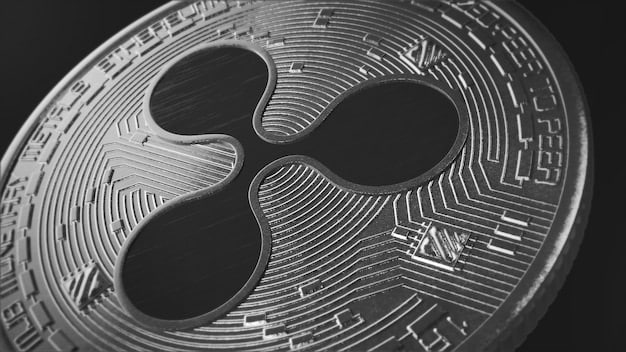Decoding Altcoin Liquidity Pools: Spotting Risks & Maximizing Returns

Decoding Altcoin Liquidity Pools involves understanding how these decentralized pools function, identifying potential red flags such as low trading volume or impermanent loss, and employing strategies to maximize yields, potentially reaching up to 15% through careful selection and risk management.
Navigating the world of altcoin liquidity pools can be both exciting and daunting. While they offer opportunities for significant returns, they also come with inherent risks. This article serves as your guide to decoding Altcoin Liquidity Pools: How to Spot Red Flags and Maximize Yields by 15%, ensuring you make informed decisions.
Understanding Altcoin Liquidity Pools
Altcoin liquidity pools are the backbone of decentralized exchanges (DEXs), enabling users to trade cryptocurrencies without intermediaries. But what exactly are they, and how do they work?
In essence, a liquidity pool is a collection of cryptocurrencies locked in a smart contract. These pools provide the liquidity needed for traders to execute buy and sell orders instantly. Instead of relying on traditional market makers, DEXs use these pools to facilitate trading.
How Liquidity Pools Function
Liquidity pools operate using an Automated Market Maker (AMM) mechanism. This algorithm determines the price of assets based on the ratio of tokens within the pool. When a trade occurs, the balance of tokens in the pool shifts, causing the price to adjust.
The Role of Liquidity Providers
Liquidity providers (LPs) are individuals who contribute tokens to the pool. In return, they receive a portion of the trading fees generated by the pool. This incentivizes users to provide liquidity, ensuring that the DEX remains functional and efficient.
- Earn Trading Fees: LPs earn a percentage of the trading fees proportional to their share of the pool.
- Decentralized Finance (DeFi) Participation: LPs actively participate in the DeFi ecosystem, fostering decentralized trading.
- Potential for High Returns: By providing liquidity to promising altcoins, LPs can potentially earn high returns.
Ultimately, understanding the basic mechanics of altcoin liquidity pools is crucial for anyone looking to participate in decentralized finance. By grasping the roles of AMMs, LPs, and the underlying smart contracts, you can better assess the risks and rewards associated with these pools.
Identifying Potential Red Flags
While liquidity pools offer compelling opportunities, it’s essential to recognize potential red flags that could lead to financial losses. These red flags can range from technical issues to manipulative practices.
Before investing in any liquidity pool, due diligence is paramount. Always research the project, the team behind it, and the underlying smart contract to identify any potential vulnerabilities.

Low Trading Volume
One of the primary red flags is low trading volume. Pools with minimal activity are often less profitable and more susceptible to price manipulation. Low volume can also indicate a lack of interest in the altcoin, which could lead to its value declining.
Impermanent Loss (IL)
Impermanent loss occurs when the price of the tokens in the pool diverge significantly. This can result in LPs receiving less value than they initially deposited. Understanding IL is crucial to managing risk in liquidity pools.
- Price Divergence: The greater the price difference between the tokens, the higher the IL.
- Risk Mitigation: Strategies like providing liquidity in stablecoin pairs can help reduce IL.
- Monitoring: Regularly monitor the pool’s performance and adjust your strategy as needed.
In short, spotting red flags early can save you from significant financial losses. By carefully evaluating the risk factors associated with liquidity pools, you can make more informed decisions.
Maximizing Yield Potential
Once you’ve identified and mitigated the risks, the next step is to maximize your yield potential. This involves selecting the right pools, employing effective strategies, and continuously monitoring your investments.
One popular method for boosting yields is yield farming, where LPs stake their tokens in multiple pools to earn additional rewards. However, it’s important to manage your portfolio actively to avoid overexposure to any single asset.
Choosing the Right Pools
Selecting the right liquidity pools is essential for maximizing returns. Look for pools with high trading volume, low impermanent loss, and attractive rewards.
Yield Farming Strategies
Yield farming involves staking your LP tokens to earn additional rewards. However, it’s crucial to evaluate the risks associated with each farm, including the potential for rug pulls and smart contract exploits.

- Staking Rewards: Earn additional tokens by staking your LP tokens in yield farms.
- Diversification: Spread your investments across multiple farms to reduce risk.
- Security Audits: Ensure that the yield farms have undergone thorough security audits to minimize the risk of exploits.
In summary, maximizing yield potential requires a combination of strategic pool selection, active portfolio management, and a keen understanding of the DeFi landscape.
Case Studies: Successful Altcoin Liquidity Strategies
Examining successful case studies can provide valuable insights into effective liquidity provision strategies. These examples offer practical lessons and demonstrate how to navigate the complexities of altcoin liquidity pools.
By studying real-world examples, you can gain a deeper understanding of the factors that contribute to success and the common pitfalls to avoid.
Case Study 1: Stablecoin Pair Dominance
One successful strategy involves providing liquidity to stablecoin pairs. These pools typically have lower impermanent loss and provide a steady stream of trading fees. For example, a pool pairing USDT and USDC can offer a low-risk, consistent return.
Case Study 2: Strategic Altcoin Selection
Investing in promising altcoins with strong fundamentals can also yield significant returns. However, this approach requires thorough research and careful selection. Consider projects with innovative technology, strong community support, and a clear use case.
- Research Fundamentals: Evaluate the project’s technology, team, and market potential.
- Community Engagement: Assess the level of community support and engagement.
- Risk Management: Implement robust risk management strategies to protect your investments.
In conclusion, these case studies highlight the importance of strategic pool selection, thorough research, and proactive risk management in achieving success with altcoin liquidity pools.
Tools and Resources for Altcoin Liquidity Analysis
To effectively analyze and navigate altcoin liquidity pools, it’s essential to leverage the right tools and resources. These resources can help you monitor pool performance, track impermanent loss, and identify potential risks.
From specialized dashboards to community forums, a variety of tools are available to assist you in your liquidity provision journey. By utilizing these resources, you can make more informed decisions and optimize your returns.
DeFi Tracking Dashboards
DeFi tracking dashboards provide real-time data on liquidity pool performance, including trading volume, APR, and impermanent loss. These dashboards can help you quickly assess the profitability and risk associated with different pools.
Impermanent Loss Calculators
Impermanent loss calculators allow you to estimate the potential loss based on the price divergence of tokens in the pool. These tools can help you make informed decisions about when to enter and exit a pool.
- Real-Time Data: Access up-to-date information on pool performance and market trends.
- Risk Assessment: Evaluate the potential risks associated with impermanent loss.
- Community Support: Engage with other LPs and share insights and strategies.
To summarize, by utilizing these tools and resources, you can enhance your ability to analyze and navigate altcoin liquidity pools, ultimately leading to more informed investment decisions.
Future Trends in Altcoin Liquidity Pools
The world of altcoin liquidity pools is constantly evolving, with new technologies and strategies emerging regularly. Staying informed about future trends can help you stay ahead of the curve and adapt to the changing landscape.
From layer-2 scaling solutions to decentralized insurance protocols, a variety of innovations are poised to shape the future of altcoin liquidity pools. By keeping an eye on these trends, you can position yourself for continued success.
Layer-2 Scaling Solutions
Layer-2 scaling solutions, such as Polygon and Arbitrum, can significantly reduce transaction fees and increase transaction speeds on DEXs. This can make liquidity provision more accessible and profitable for a broader range of users.
Decentralized Insurance Protocols
Decentralized insurance protocols offer coverage against smart contract exploits and other risks associated with liquidity pools. These protocols can provide peace of mind and encourage more users to participate in DeFi.
- Increased Efficiency: Layer-2 solutions can enhance the efficiency and scalability of DEXs.
- Enhanced Security: Insurance protocols can protect against financial losses from smart contract exploits.
- Adaptability: Staying informed about emerging trends can help you adapt your strategies and maximize returns.
Therefore, by staying informed about future trends and embracing innovative technologies, you can position yourself for continued success in the dynamic world of altcoin liquidity pools.
| Key Point | Brief Description |
|---|---|
| ⚠️ Spotting Red Flags | Identify risks like low volume and impermanent loss to avoid pitfalls. |
| ✅ Maximizing Yields | Choose profitable pools and use yield farming to increase returns. |
| 📚 Case Studies | Learn from successful strategies with Altcoin Liquidity. |
| 🛠️ Useful Tools | Use tools for tracking pool performance and risk assessment. |
Frequently Asked Questions
▼
Impermanent loss occurs when the price ratio of tokens in a liquidity pool diverges, leading to a decrease in value compared to holding the tokens outside the pool.
▼
Consider factors like trading volume, APR, and the risk of impermanent loss. Research the project and team behind the altcoin before providing liquidity.
▼
Yield farming involves staking LP tokens to earn additional rewards. Diversify your investments across multiple farms and assess the risks of each farm carefully to maximize returns.
▼
Diversify your investments, use stablecoin pairs, and monitor pool performance regularly. Ensure the smart contracts have undergone security audits to minimize the risk of exploits.
▼
Future trends include layer-2 scaling solutions, decentralized insurance protocols, and innovative risk management tools. Staying informed will help you adapt to changes and maximize returns.
Conclusion
Decoding altcoin liquidity pools requires a blend of vigilance, strategic thinking, and continuous learning. By understanding the mechanics of these pools, identifying red flags, maximizing yield potential, and leveraging the right tools and resources, you can navigate the DeFi landscape with confidence and potentially achieve significant returns. Staying informed about future trends and adapting to the evolving market will be essential for long-term success.





